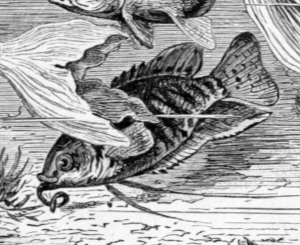In the first part of his article (described here), dr. Ruß showed the readers how to set up a thriving aquarium with plenty of healthy plants. Now, what about fish? He distinguishes between two types of fish tanks according to their purpose. The first type is designated for observing fish and includes aquariums in natural history institutes and zoos. In this type of tanks, Ruß states, fish are constantly disturbed and breeding is hard to accomplish. Then there’s the second type of fish tanks where its inhabitants can breed in peace and the offspring are safe from predators – in this case, tank mates must be chosen carefully.
Many people shake their heads incredulously when I talk about breeding fish in the household. And yet we can set up such (an aquarium) easily and suceed with it significantly. (p. 668)
The most suitable fish for breeding according to Ruß is “Macropodus venustus” (today known as Marcopodus opercularis, the paradise fish). It was the first ornamental fish imported to Europe after goldfish – in 1869 to France and in 1876 to Germany (see FishBase). The author describes how the bubble nest is build and fertilized eggs are transported by the male; once the offspring starts to leave the nest, Ruß recommends to move the parents to a separate tank in order to stimulate another reproduction cycle and to prevent the offspring to be eaten; nevertheless he admits that even when the adults stay, the surviving rate of their offspring is quite high. (By the way, I noted that Ruß as a renowned ornithologist uses a few terms that are commonly associated with bird, not fish breeding.)

The author also mentions Gourami fish (maybe Trichogaster fasciata?) from Sunda islands, at that time still scarce in Europe (or at least in Germany). He goes on with a fish he calls “Stichling”, in English stickleback, which is some fish from the family Gasterosteidae (certainly one of the European freshwater species). These fish also build a nest (although not a bubble nest like the paradise fish) but as dr. Ruß points out, succesful breeding is more tricky with sticklebacks – plus we can’t keep them in a community tank because of their hostility. Today, it is also not a common fish in aquariums.

Dr. Ruß then turns his attention to his community tank where a mix of carp fish (cyprinids) and goldfish is dominant. He mentions a breeder of these fish who supplied whole Europe with them – P. Matte in Lankwitz near Berlin (today it is a part of Berlin). In a community tank with larger fish we can, according to dr. Ruß, also keep some predatory fish. He names European mudminnow (Umbra krameri) from Hungary and further wels catfish (Silurus glanis), European perch (Perca fluviatilis), ruffe (Gymnocephalus cernua) or pike (Esox lucius) – but only when they are young and therefore small enough.

For a temporary stay in the tank he further recommends common minnow (Phoxinus phoxinus), European bitterling (Rhodeus amarus) or tench (Tinca tinca), also known as doctor fish. Yet he does not forget to warn the readers that too many fish cause problems in the tank. If we want to keep e. g. European weatherfish (Misgurnus fossilis), we must have a tank with lush plant growth und since these fish as well as carp and goldfish often eat and/or damage water plants, we must be ready to replace the plants whenever needed.
Dr. Ruß postulates that all fish without exceptions prefer meat, thus we should feed them with ant eggs, “white worms” (dried mayflies) and fresh meal in an amount they can consume immediately. To feed the above mentioned predatory fish, there must be number of small cheap fish in the tank. In summer, we can collect small water animals like water fleas (Cladocera). On the other hand, Ruß advises against feeding with bread, bran, wheat wafers etc. Yet he also warns that with food from nature we can bring a fish parasite to the tank – Argulus foliaceus (common fish louse). In the end he also doesn’t forget to stress that when there are small (young) fish in the tank, we must avoid to bring there Hydrophilidae (water scavenger beetles) or dragonfly larvae.
In order to prevent the rest of the food to spoil the water, we add snails, but not too many, for they also are destroyers of plants. (p. 669)

The presented article is exceptional thanks to its extensiveness, expertise of its author and also the one huge, beautiful, detailed illustration.
RUß, Karl. Schmuck- und Liebhabereifische in der Häuslichkeit. Neue illustrirte Zeitung. 1887, vol. 15, no. 42, p. 667-669. Also available at: http://anno.onb.ac.at/cgi-content/anno?aid=niz&datum=18870717.